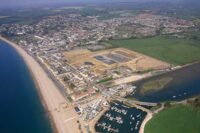 Constructed on a site sitting two metres below the flood plain, the scheme has required extensive enabling works to raise the ground level to protect any development from the threat of flooding. A pioneering approach to preparing the site for construction has seen an innovative application of existing technology, resulting in what is believed to be the first inland dredging project to have been completed in the UK.
Constructed on a site sitting two metres below the flood plain, the scheme has required extensive enabling works to raise the ground level to protect any development from the threat of flooding. A pioneering approach to preparing the site for construction has seen an innovative application of existing technology, resulting in what is believed to be the first inland dredging project to have been completed in the UK.
Over 300,000m3 of sand was dredged from the sea bed and pumped through a 3.6km pipeline, with 1.5km of pipeline resting on the sea bed and the remainder snaking over land on temporary bridges, delivering the dredged material into specially-constructed bunded reception pits on site. On arriving into the reception pit, the sea water was drained from the sand into a vacant bunded lagoon before being pumped back out to sea using two powerful V12 pumps.
Once all the sand had been deposited, ISG excavated this material from the reception pits and deposited it across the site to build up the ground levels. The entire process was carefully monitored by geotechnical engineers to ensure that the fill material provided a stable and permanent base for construction of the store and future residential land.
The 60,000 ft2 store itself occupies around a third of the site, the remainder of which is being marketed for additional development opportunities. The timber frame building uses a concrete raft slab foundation, which ISG has pioneered for supermarket builds, and Seaton is believed to be the first store that Tesco has commissioned using this innovative construction method. The use of the concrete raft slab has not only fast-tracked the build programme but also removed the need for any excavations or piling, apart from those required for drainage, reducing time and ultimately enhancing cost savings.
The new store opened on the 21st November, providing an excellent lead in for the busy Christmas period and provides a complete Tesco offer including ambient, grocery, white goods and clothing.
Andy Demetriou, ISG’s operations director of UK Retail, commented: “The original plan for the site was to bring in truckloads of fill by road, however this would have taken an estimated four years to complete and contributed to increased traffic on the local road infrastructure. ISG proposed the innovative dredged sand solution, which received overwhelming support as this would reduce the environmental impact of four years of truck movements in the locality.
“The dredging process involved a 12-week enabling programme, which included installing the pipeline and temporary bridges across public highways, as well as the construction of the reception pits. The actual dredging process itself took just four weeks to complete with all the material derived from licensed underwater sea quarries.
“As a result, the development programme was dramatically shortened and the use of a concrete raft slab foundation provided further time and cost savings. This unique project provides an excellent example of how flood plain sites can be developed in a commercially viable manner and we are delighted with the outcome of our most challenging scheme for Tesco to date.”
ISG Plc




Comments are closed.